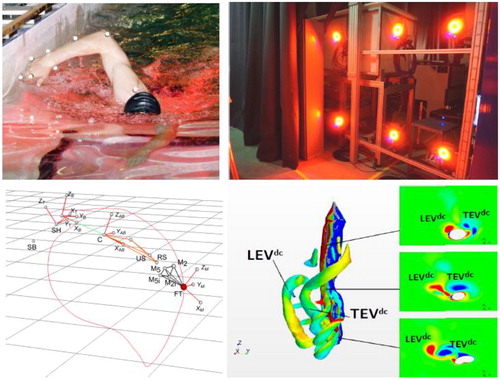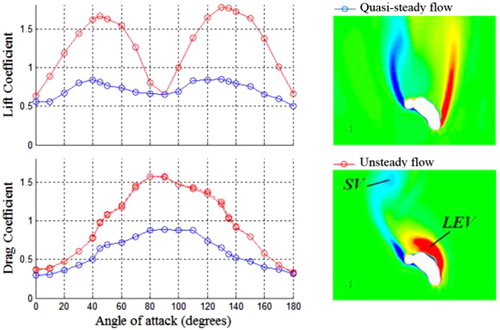1. Introduction
Competition swimming aims to achieve high performance. For this, the swimmer must increase propulsive forces while decreasing the drag. These forces are produced by the movements of the swimmer’s arms and legs in a fluid at rest. The locally generated flow created these hydrodynamic forces. Analyzing this flow allows to understand the techniques used by expert swimmers. For many years this flow has been studied from a quasi-steady approach, that is to say that the flow parameters were independent of time. On the contrary, it appears that the flow is very unsteady (Toussaint et al. Citation2002; Kudo et al. Citation2013; Samson et al. Citation2015), and that it must therefore be studied according to this model. Tools and knowledge have evolved in recent years and now make it possible to carry out such studies. This is the purpose of this article which aims to present the unsteady studies of swimming that we are currently performing in the P’ laboratory.
2. Methods
The unsteady methods we use to study the fluid are complementary: they are both experimental and numerical and local and global. Several experimental methods are used to perform kinematic or dynamic measurements. The kinematic measurements are made from an optoelectronic system that measure the three-dimensional trajectories of the different segments (Monnet et al. Citation2014, ). PIV measurements (Particle Image Velocimetry) are performed to measure flow velocity fields. A tethered swimming device measures the propulsive forces and allow to calculate the mean impulse (Samson et al. Citation2018a). At the same time, numerical simulations have been made using a Unsteady Reynolds Averaged Navier Stokes (URANS) method in order to obtain all the data (pressure, force, velocity) but also to follow the spatio-temporal evolution of the vortices over time. (Samson et al. Citation2017, Citation2018b, ). These vortices play a key role in the generation of propulsive forces. Experimental measurements allow to validate our numerical model.
3. Results and discussion
These different studies have shown the very unsteady nature of the flow in swimming and have highlighted a number of effects that play an important role in the generation of hydrodynamic forces.
3.1. Basic kinematic parameters
We have shown that the important kinematic parameters in the generation of propulsive forces are: the angle of attack of the fluid with respect to the hand, the orientation of the arms with respect to the direction of advancement, the velocity and acceleration of the hand and forearm. Optimal angles of attack range from 45° to 70° (Samson et al. Citation2017). This corresponds to the angles we measured on expert swimmers: 62° on average during the insweep phase and 40° during the upsweep phase (Samson et al. Citation2015). Given these high angles of attack, the movement in crawl can be described as rowing
3.2. The pressure forces predominate
Hydrodynamic forces are the result of pressure component (perpendicular to surfaces) and friction component (tangential to surfaces). We have shown (Samson et al. Citation2017) that the pressure was the mean contribution (close to 95% of the total force). This is justified because the flow is turbulent (Reynolds number ≈ 105): inertia forces are much higher than those of viscosity. The hydrodynamic forces are therefore almost perpendicular to the hand and forearm. To be effective, the swimmers will, as soon as possible and as long as possible, direct their hand and forearm perpendicular to the forward direction to direct the hydrodynamic forces in the forward direction.
3.3. Kramer effect
During the aquatic stroke, the hand performs phases of pronation and supination. These phases of rotation of the hand (internal or external) generate an additional circulation of fluid around the hand and forearm which contributes favorably (or unfavorably) to the creation of propulsive forces (called « Kramer effect »). We have shown that the front crawl pronation phases coincide with peaks of force (Samson et al. 2019). In addition, this allows a favorable orientation of the hands to direct the forces in the forward direction. These rotations also make it possible to optimize the angle of attack of the fluid.
3.4. Axial flow
Toussaint et al. in 2002 showed that there was an axial flow in the front crawl along the forearm and hand that was due to the gradient of velocity between the elbow and the hand. We have shown, through a numerical study, that this axial flow acts favorably to the creation of propulsive force (Samson et al. Citation2018c). Indeed, axial flow allows an evacuation of a part of vorticity and thus has a tendency to stabilize the leading edge vortex (LEV) on the back of the hand.
3.5. Delayed stall effect
The delayed stall effect is associated with the boundary layer separation present in a flow governed by a moving profile with a high angle of attack in a surrounding fluid. When a profile is set in motion at high angle of attack in a surrounding fluid (as is the case in swimming), the current lines take off at the leading edge to pick up upstream of the trailing edge. This separation is similar to the formation of a recirculation zone (LEV, ) which is highly low-pressure area at the extrados, and therefore generates increased force. We have shown in a parametric study (Samson et al. Citation2017, ) that the delayed stall effect could double the force with respect to quasi-steady flow.
3.6. Added mass effect
The added mass effect plays a key role during unsteady flows. This effect is not of circulatory origin as the previously explained effects (but acts in conjunction with them). It emanates from Newton’s second law: a force applied to a body that is in a fluid is partially used to communicate an acceleration to surrounding fluid particles. This effect is called “added mass”. Some authors have shown the role of this effect in swimming. For instance Kudo et al. in 2013 have shown hydrodynamic forces on the accelerating hand were between 1.9 and 10 times greater than for the non-accelerating hand.
4. Conclusions
The different unsteady effects play a key role in the generation of forces in swimming. If one wants to finely analyze the technique of the swimmers and thus be able to act on it to optimize the performances, one must more analyze and understand these effects. It also means that we have to change our analysis model and go beyond the quasi-steady model (which is unsuitable for swimming) to move towards the unsteady model.
References
- Kudo S, Vennell R, Wilson B. 2013. The effect of unsteady flow due to acceleration on hydrodynamic forces acting on the hand in swimming. J Biomech. 46(10):1697–1704.
- Monnet T, Samson M, Bernard A, David L, Lacouture P. 2014. Measurement of three dimensional hand kinematics during swimming with a motion capture system: a feasibility study. Sports Eng. 17(3):171–181.
- Samson M, Monnet T, Bernard A, Lacouture P, David L. 2015. Kinematic hand parameters in front crawl at different paces of swimming. J Biomech. 48(14):3743–3750.
- Samson M, Monnet T, Bernard A, Lacouture P, David L. 2017. Unsteady computational fluid dynamics in front crawl swimming. Comput Methods Biomech Biomed Engin. 20(7):783–793.
- Samson M, Monnet T, Bernard A, Lacouture L, David L. 2018a. Comparative study between fully tethered and free swimming at different paces of swimming in front crawl. Sports Biomech. (Published online: 21 Mar 2018).
- Samson M, Monnet T, Bernard A, Lacouture P, David L. 2018b. Analysis of a swimmer’s hand and forearm in impulsive start from rest using computational fluid dynamics in unsteady ow conditions. J Biomech. 67:157–165.
- Samson M, Monnet T, Lacouture P, David L. 2018c. Unsteady computational fluid dynamics of the axial ow generated by the rotation of an arm in swimming. XIIIth International Symposium on Biomechanics and Medicine in Swimming, 17-21 September, Tsukuba, Japan.
- Toussaint H, Berg C, Beek W.J. 2002. pumped-up propulsion” during front crawl swimming. Med Sci Sports Exer. 34(2):314–319.


